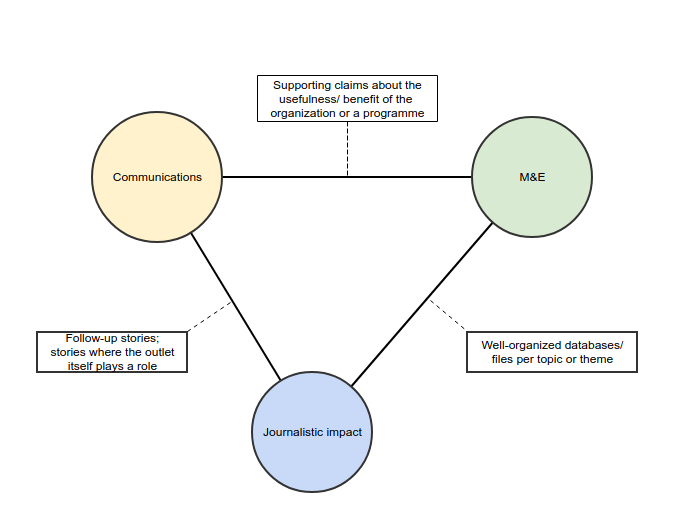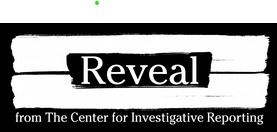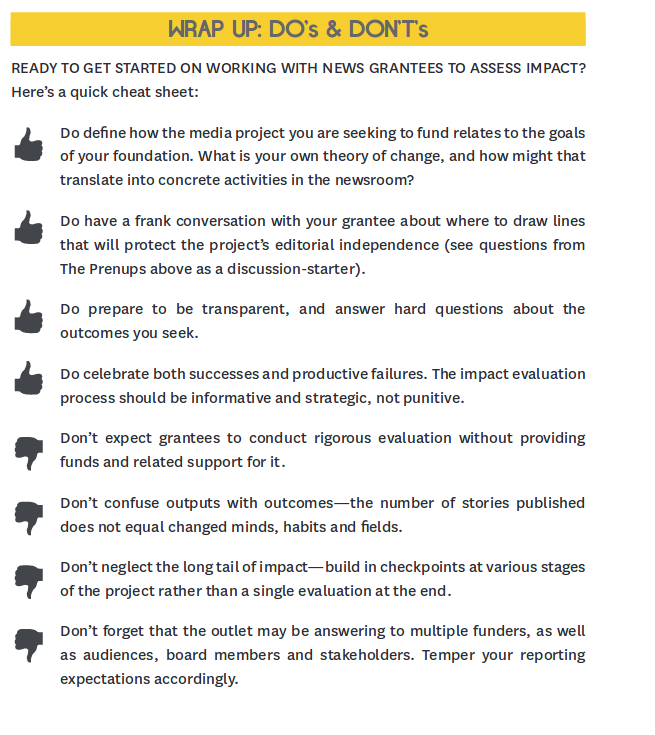Activists can pick up the baton and follow-up on stories for greater political and societal impact. Knowing when a journalist’s job stops and an activist’s begins varies per story and situation. However, this section will offer some examples of successful impact tracking and key resources, which will hopefully assist journalists in deciding when to monitor and evaluate their own work and when to handover the investigation to activists or grantees.
The challenge of tracking impact
In our vision, (investigative) journalism holds powerholders to account and has an impact on wider society. The specific impact of a single story (or series of stories) is often hard to track, however.
The Media Impact Project (based at the University of Southern California), has identified three gaps in the current understanding of media impact:
- While the metrics used to measure reach (outputs) are fairly easy to compare between projects, studies that compare differences in impact (outcomes) often require self-report and are costlier and difficult to implement.
- Additionally, while a typical evaluation answers the vital question of whether a media initiative worked, it does not address important questions about how and for whom media works best.
- Finally, even when impacts are measured, they are typically done so immediately following exposure – after a screening, online experiment, or campaign. Therefore, little is known about the long-term (tail) effects of media interventions — e.g., do observed effects last beyond a few moments after the person has engaged with the content?
Why impact should be tracked
Despite the challenge, tracking the impact of stories can be a very worthwhile endeavor with multiple applications. Beyond learning how to continue creating impactful stories in the future, journalists can also build a clear track record (especially important for non-profit media outlets applying for grants). Impact tracking offers journalists the opportunity to create input for follow-up stories describing the societal impact that followed the earlier publication. This is a great way to reveal to the wider public how that impact came to be.

Important note:
While impact is important, it is essential to keep the dividing line between journalists and activists in mind. While we want media content in general to have impact, it is an open question how deliberate a journalist or media outlet should be about having any particular investigation result in a particular (political) outcome.
The outcome harvesting method
Outcome harvesting is a participative Monitoring and Evaluation (M&E) method that Free Press Unlimited and our partners have used to analyse press organisations’ results. The method is particularly useful for:
- Tracking the impact of complex media contexts (including numerous actors and factors)
- Training media professionals to consciously consider societal impacts
The reasons why media outlets and their partners would use this method is to evaluate the results of publications on an outcome level. It can help media professionals switch from an activity-focused mindset to an outcome-focused way of thinking. The technique involves:
- Determining what has changed
- Working backwards to see which activities contributed to the change
Find out more about impact tracking via the cooperation between investigative journalists and CSOs in the Tempo Media programme.
Resources for tracking impact in a project or with grantees

Free Press Unlimited has been developing a table to use to track the impact of stories. This is being trialled by our media partners and their feedback means we are changing and improving it on a rolling basis.
- or here in Arabic

The Media Impact Project has developed a glossary of (offline) impact indicators. While this does not provide a tool to track impact directly, the glossary defines and organises elements that can be used to build up a set of indicators for tracking impact.
Click here for the glossary


Read more – creating impact:
Investigative Journalism Works: The Mechanism of Impact – a collection of case studies ‘looking in detail at some examples of investigative journalism that have had an impact to find out how this was achieved’.
Three common factors of investigations that succeeded in having a high impact is that they:
- are sustained over a period of time.
- interact with civil society (researchers, politicians, the legal process or campaigning groups)
- have a clear idea of the target audience. These may be politicians and policy makers directly or the public, which can exert pressure
